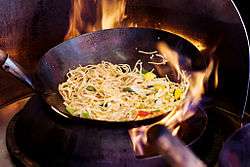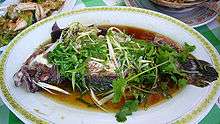Chinese cooking techniques

Chinese cooking techniques (Chinese: 中餐烹調法) are a set of methods and techniques traditionally used in Chinese cuisine.[1] The cooking techniques can either be grouped into ones that use a single cooking method or a combination of wet and dry cooking methods.
 |
| This article is part of the series |
| Chinese cuisine |
|---|
|
Regional cuisines
|
|
Ingredients and types of food |
|
|
Single
Many cooking techniques involve a singular type of heated cooking or action.
Wet
Wet-heat, immersion-based cooking methods are the predominate class of cooking techniques in Chinese cuisine and are usually referred to as zhǔ (煮). In fact the term zhǔ is commonly used to denote cooking in general.
Quick
Fast wet-heat based cooking methods include:
| English Equivalent | Chinese | Pinyin | Description |
|---|---|---|---|
| Braising | 烧 | Shāo | Braising ingredients over medium heat in a small amount of sauce or broth and simmering for a short period of time until completion. Known as hong-shao (红燒, lit. red cooked) when the sauce or broth is soy sauce based. |
| Quick Boiling | 氽 or 煠 | Dǔn or Zhá | Adding ingredients and seasonings to boiling water or broth and immediately serving the dish with the cooking liquid when everything has come back to a boil. |
| Scalding | 焯 or 烫 | Chāo or Tàng | Par cooking through quick immersion of raw ingredients in boiling water or broth sometimes followed by immersion in cold water. |
Prolonged
Prolonged wet-heat based cooking methods include:
| English Equivalent | Chinese | Pinyin | Description |
|---|---|---|---|
| Bake stewing | 煨 | Wēi | Slowly cooking a ceramic vessel of broth and other ingredients by placing it in or close to hot embers. |
| Gradual simmering | 炖 | Dùn | Adding ingredients to cold water along with seasonings and allowing the contents to slowly come to a prolonged simmering boil. This is known in English as double steaming due to the vessels commonly used for this cooking method. The term is also used in Chinese for the Western cooking technique of stewing and brewing herbal remedies of Traditional Chinese medicine. |
| Slow red cooking | 卤 | Lǔ | Cooking over prolonged and constant heat with the ingredients completely immersed in a strongly flavoured soy sauce based broth. This technique different form, but in English, synonymous with Hóng shāo (红燒). |
| Steaming | 蒸 or 燖 | Zhēng or Xún | Steaming food to completion over boiling water. |
| Decoction | 熬 | Áo | Cooking slowly to extract nutrients into the simmering liquid, used to describe the brewing process in Chinese herbology with the intention of using only the decocted brew. |
Dry
Air-based

Food preparation in hot dry vessels such as an oven or a heated empty wok include:
| English Equivalent | Chinese | Pinyin | Description |
|---|---|---|---|
| Baking or Roasting | 烤 | Kǎo | Cooking by hot air through convection or broiling in an enclosed space |
| Smoking | 熏 | Xūn | Cooking in direct heat with Smoke. The source of the smoke is typically sugar or tea. |
Oil-based

Oil-based cooking methods are one of the most common in Chinese cuisine and include:
| English Equivalent | Chinese | Pinyin | Description |
|---|---|---|---|
| Deep frying or Frying | 蒸 | Zhá | Full or partial immersion cooking in hot oil or fat |
| Pan frying | 煎 | Jiān | Cooking in a pan with a light coating of oil or liquid and allowing the food to brown. |
| Stir frying or high heat Sautéing | 炒 | Chǎo | Cooking ingredients at hot oil and stirring quickly to completion. This technique, as well as bào chǎo and yóu bào (爆炒 and 油爆), is known in English as stir frying. This technique uses higher heat than that of Sautéing. |
| Flash-frying or High heat Stir frying | [油]爆 | [Yóu]Bào | Cooking with large amounts hot oil, sauces (酱爆; jiàng bào), or broth (汤爆; tāng bào) at very high heat and tossing the ingredients in the wok to completion. |
Stir frying
Kian Lam Kho identifies five distinct techniques of stir frying:[2]
| English Equivalent | Chinese | Pinyin | Description |
|---|---|---|---|
| Plain stir-fry or Simple stir-fry | 清炒 | qīngchǎo | To stir-fry a single ingredient (with aromatics and sauces). A plain stir-fry using garlic is known as 蒜炒, suànchǎo.[3] |
| Dry stir-fry or Dry wok stir-fry | 煸炒 | biānchǎo | To stir-fry a combination of protein and vegetable ingredients (with a small amount of liquid)[4] |
| Moist stir-fry | 滑炒 | huáchǎo | To stir-fry a combination of protein and vegetable ingredients (with a gravy-like sauce)[5] |
| Dry-fry or Extreme-heat stir-fry | 干煸 | gānbiān | To scorch in oil before stir-frying (with no addition of water)[6] |
| Scramble stir-fry | 软炒 | ruǎnchǎo | A technique for making egg custard. |
Without heat
Food preparation techniques not involving the heating of ingredients include:
| English Equivalent | Chinese | Pinyin | Description |
|---|---|---|---|
| Dressing | 拌 | Bàn | Mixing raw or unflavoured cooked ingredients with seasonings and served immediately. Similar to tossing a dressing into salad. |
| Marinating or pickling | 腌 | Yān | To pickle or marinade ingredients in salt, soy sauce or soy pastes. Use for making pickles or preparing ingredients for addition cooking. |
| Jellifying | 凍 | Dòng | To quickly cool a gelatin or agarose containing broth to make aspic or agar jelly |
Combination

Several techniques in Chinese involve more than one stage of cooking and have their own terms to describe the process. They include:
- Dòng (凍): The technique is used for making aspic but also used to describe making of various gelatin desserts
- Simmering meat for a prolonged period in a broth (滷; Lǔ) or (炖; dùn)
- Chilling the resulting meat and broth until the mixture gels
- Hùi (燴): The dishes made using this technique is usually finished by thickening with starch (勾芡; gōuqiàn)
- Quick precooking in hot water (燙; tàng)
- Finished by stir-frying (爆; bào, 炒; chǎo) and 燒; shāo)
- Liū (溜): This technique is commonly used for meat and fish. Pre-fried tofu is made expressly for this purpose.
- Deep frying (炸; zhà) the ingredients until partially cooked
- Finishing the ingredients lightly braising (燒; shāo) it to acquired a soft "skin"
- Mēn (燜):
- Stir-frying (爆; bào or 炒; chǎo) the ingredients until partially cooked
- Cover and simmer (燒; shāo) with broth until broth is fully reduced and ingredients are fully cooked.
See also
References
- ↑ 傅, 培梅 (2008), Péi Méi Shípǔ 培梅食譜 [Pei Mei Recipes], 1, 旗林文化, ISBN 978-986-6655-25-8
- ↑ Kho, Kian Lam. Phoenix Claws and Jade Trees: Essential Techniques of Authentic Chinese Cooking.
- ↑ Kho, Kian Lam. "Stir-fry Fortnight III – Plain Veggie Stir-fry". Red Cook. Retrieved 31 December 2015.
- ↑ Kho, Kian Lam. "Stir-fry Fortnight V – Dry Wok Stir-fry". Red Cook. Retrieved 31 December 2015.
- ↑ Kho, Kian Lam. "Stir-fry Fortnight IV – Moist Stir-fry". Red Cook. Retrieved 31 December 2015.
- ↑ Kho, Kian Lam. "Stir-fry Fortnight V – Dry Wok Stir-fry". Red Cook. Retrieved 31 December 2015.
